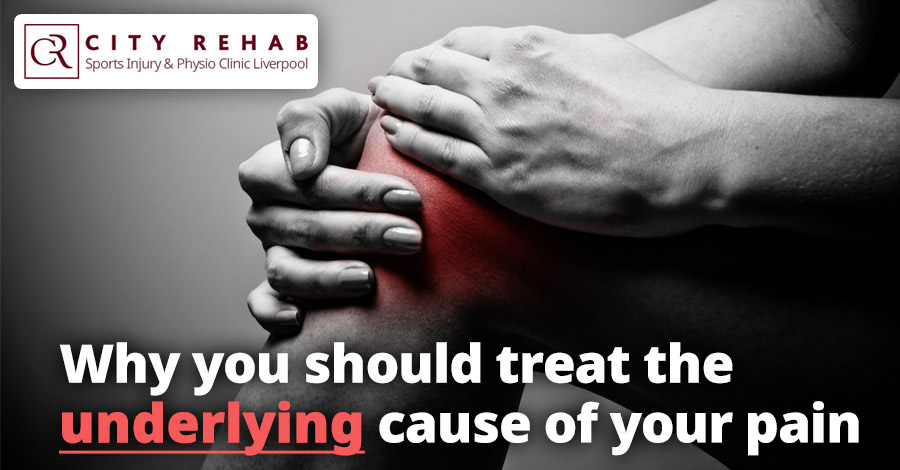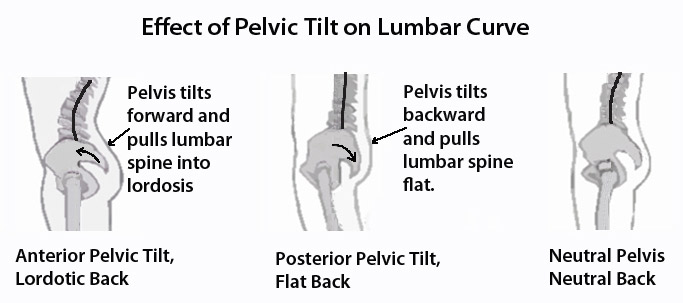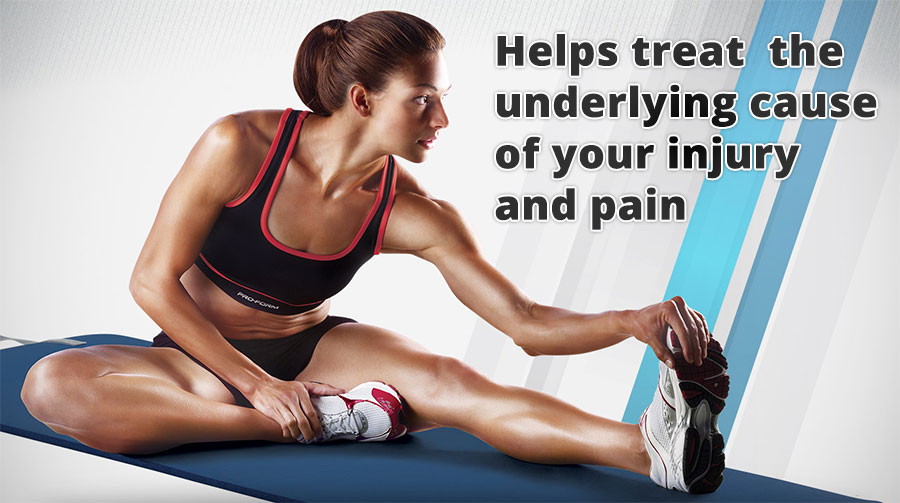Rehab exercises: Treating the underlying cause of your injury & pain!

So we’ve discussed what we do with you when you come into clinic and why, we’ve also talked about why we send you away with those pesky stretches to do; now we want to touch upon the reason behind all those weird and wonderful exercises we give you.
By now you should have an understanding that here at City Rehab, we first and foremost aim to reduce your symptoms, increase your mobility and generally make you much more comfortable by settling your injury down. However, if that was all we were to do then over time it is highly likely that the same injury would return, frustrating us but more importantly you!
Why it's important to treat your injury from the outset
If the cause of your injury isn’t treated from the outset then chances are your pain will return and you’ll be forced to take more time away from your sport or activity, reduce or stop training and seek more sports rehabilitation or physiotherapy which ends up costing you more! As Sports Rehabilitation specialists, we pride ourselves on treating the underlying cause of your pain, not just your symptoms. We aim to do this by educating you and your body about your injury and this is where the emphasis on complying with your exercise programme is essential.
Manual therapy plays a key role in improving the symptoms of your injury
As we’ve discussed in previous blogs, manual therapy plays a key role in improving the symptoms of your injury and stretching helps to maintain those benefits, so where do the exercises come in? It is with the performance of the exercises that the root cause of your injury is tackled, not only do we want to reduce your pain but we want to make sure that we minimise the risk of it returning. You may have heard us use the phrase “loosen what’s tight and strengthen what’s weak”, this is the basic principle for most musculoskeletal injuries as it’ll be the tight /overactive structures that will pull your body out of position while the weak /underactive structures will allow this to happen. If we combine both problems the result is poor joint or limb movement and pain! The corrective exercises allow us to re-educate the body by breaking bad habits and laying down new ones, thus creating improved, more efficient movement patterns. If we can correct the biomechanical fault that lead to your injury then we can ensure that you won’t suffer with the same issue again.
A simple example of this imbalance (see the diagram below) is someone with lower back pain which is caused by overactive quads (thigh muscles) and lower back muscles and underactive abdominals and glutes. This causes what we call an anterior pelvic tilt and a Lordosis posture, where your lower back is arched excessively. In this case the Lumbar vertebrae facet joints are forcibly compressed which results in pain.

Now unfortunately there are no quick-fixes with injury rehabilitation; re-educating the body isn’t an overnight occurrence, it does take time and perseverance as well as some effort on your part. There is only so much we can do, we need your input too! The more compliant you are with your home exercise programme, the faster things will start to resolve which means you’ll be in less pain, you’ll get back to activity sooner and of course the added bonus of spending less money to come and see us. It is equally important to keep up with your rehabilitation even after your pain subsides, we all know how easily bad habits creep back in and if the brain and body are not constantly reminded to behave in the more competent manner in which you’ve taught them then it is possible that your injury will return.
We believe that an injury should be dealt with in full from the moment it occurred
Injury rehabilitation requires a combination of hands-on treatment, stretching and strengthening exercises in order to fully resolve the whole problem. We believe that an injury should be dealt with in full, from the moment it occurred and reducing the acute symptoms, right through to getting you back to full activity, pain free of course, and without reoccurrence. Most musculoskeletal injuries are as a result of some sort of biomechanical fault and /or muscle imbalance which can lead to overload of muscles, ligaments, joints and nerves and therefore leads to injury. Corrective exercises allow us to minimise the risk of this happening by re-educating the body and restoring biomechanical equilibrium. It is essential that the root cause of your injury is dealt with via these remedial exercises because without them the injury rehabilitation process will be missing a vital link.
Stretching: What’s all the fuss about?

In our last blog we discussed what we do with you during your treatment time, now I want to discuss, in part, what we want you to do for yourselves away from the clinic, and most importantly why!
More often than not, after your first session with us, you will be sent away with a few exercises to be getting on with and initially this home exercise programme (HEP) will consist of some stretches. Stretching is a form of physical exercise whereby a muscle is deliberately elongated to principally improve its’ elasticity and tone. It is suggested that stretching can enhance athletic performance, aid in the prevention of injuries as well as assist in musculoskeletal injury rehabilitation; the latter being our primary focus. There are several forms of stretching including dynamic, ballistic and proprioceptive neuromuscular facilitation (PNF) stretching. However, for the purpose of this blog, we will be focussing on static stretching.
An improvement in muscular flexibility will help to reduce pain and tension
To statically stretch a muscle, is to place it at its’ greatest possible length and hold it there for a period of time. Our main aim with performing static stretches is to increase the muscles’ flexibility. Flexibility has been defined as “the ability of a muscle to lengthen (Zachazewski., 1989), allowing one joint (or more than one joint in a series) to move through a range of motion (ROM).” If a muscle has poor flexibility, its’ capacity to deform is reduced leading to a decrease in ROM of the joint/s in which it surrounds. An improvement in muscular flexibility will help to reduce pain and tension but it will also promote more efficient movement patterns and functionality (Law et al., 2009) therefore helping to correct the causative factors that lead to injury in the first place.
In short we aim to lengthen muscles that are short or overactive and strengthen muscles that are weak / underactive. This aids and re-balances normal function around joints and so treats the underlying cause of your injury and pain and not just your symptoms!
So we want you to stretch but for how long should you hold that stretch and how many times should they be performed?
Stretch a minimum of three times a day
Here at City Rehab, we generally advise you to stretch a minimum of three times a day whilst holding the stretch for at least 30 seconds; of course these are only guidelines but we find that this minimum, gains the most beneficial results. Duration of stretches varies amongst researchers but studies have shown that a stretch sustained for at least 30 seconds increases a muscles’ flexibility and the ROM of the surrounding joint/s greater than that of a stretch held for less than this time period. It is thought that before the 30 second marker, the receptors in the muscle only oppose the stretch, i.e. they do not like the fact that they are being stretched so signals are sent to tell the muscle to contract and shorten, which is the opposite of what we are trying to achieve. After 30 seconds, it is believed that the receptors switch off which then allows the muscle to relax and lengthen.
Stretch at regular intervals throughout a day
Frequency of stretching again is not clear cut amongst advocates and some studies suggest that there is no difference between performing one stretch per day and performing three stretches a day (Bandy et al., 1997). However, research is sparse when it comes to examining the longevity of gains in muscle flexibility through the use of static stretching, whether performed once a day or more; thus a clear conclusion cannot be drawn. Nevertheless, some hypothesise that continued stretching regimens are essential to maintain ROM gains (Feland et al., 2001), therefore surely stretching at regular intervals throughout a day will have much more positive effects regarding a muscles’ length and flexibility than just repeating the exercise once a day.
Stretches are a good starting point to get your rehabilitation underway
As clinicians at City Rehab we highly value the use of stretching as part of a rehabilitation programme, hence why we put so much emphasis on its’ importance. Stretches are a good starting point to get your rehabilitation underway; as we’ve discussed they improve a muscles elasticity, which in turn increases joint ROM helping to reduce pain and stiffness and also promoting improved function. Of course we understand that stretching alone isn’t going to rid you of your injury for good but coupled with other rehabilitative components, such as strengthening exercises (which will be covered in our next blog), we can certainly make a difference to your active life, and not just for the short term.
References
Bandy, W.D., Irion, J.M. &Briggler, M (1997) The Effect of Time and Frequency of Static Stretching on Flexibility of the Hamstring Muscles. Physical Therapy, 77, 1090-1096.
Feland, J.B., Myrer, J.W., Schulthies, S.S., Fellingham, G.W. &Measom, G.W (2001) The Effect of Duration of Stretching of the Hamstring Muscle Group for Increasing Range of Motion in People Aged 65 Years or Older. Physical Therapy, 81, 1110-1117.
Law, R.Y.W., Harvey, L.A., Nicholas, M.K., Tonkin, L., De Sousa, M. &Finniss, D.G (2009) Stretch Exercises Increase Tolerance to Stretch in Patients with Chronic Musculoskeletal Pain: A Randomised Controlled Trial. Physical Therapy, 89, 1016-1026.
Zachazewski, J.E (1989) Improving Flexibility. In: Physical Therapy. Scully, R.M. & Barnes, M.R (Eds), 1st Edition, Philadelphia, Lippincott, 152-153.
Manual Therapy: Why we Rub, Poke and Prod you…

Manual Therapy (MT) is a physical treatment used by various clinicians to treat musculoskeletal pain and disability. It primarily takes the form of massage, joint mobilisation and joint manipulation. As sports injury specialists, we describe MT as a hands-on approach utilising specific techniques to treat joint structures and soft tissues (such as ligaments, joint capsules and muscles) with the purpose of reducing pain, increasing joint range of motion (ROM) (Threlkeld, 1992), facilitating movement and therefore improving joint and muscle function.
Massage, Mobilisation and Manipulation
As stated, the three most distinguished forms of MT are massage, mobilisation and manipulation. Massage refers to the manipulation of superficial and deeper layers of muscle and connective tissue; it typically involves the repetitive rubbing and kneading of these soft tissues to principally improve muscle tone. Mobilisations are characterised by a low velocity passive movement (Di Fabio, 1986) applied to a joint aiming to reduce pain and/or increase mobility; they are performed as oscillatory movements of varying amplitude or as sustained stretches. Manipulation, similar to mobilisation, again is regarded as a passive movement applied to a joint but in this instance the joint is taken to its end range and a short, sharp thrust is applied. Manipulations are often associated with an audible popping or cracking sound.
MT is essential in reducing your pain and improving your function
At City Rehab we pride ourselves on the use of MT; along with accurate injury diagnosis, appropriate injury education and exercise prescription and we achieve excellent results with our patients. But why do we value this hands-on approach so significantly and how does it work? Very often massage and mobilisation forms the foundation of our treatments, particularly in the early stages of your injury. Our initial intention is to reduce your pain and improve your function; we believe MT is essential to do this.
Massage is believed to have a number of physiological effects. With regards to treating patients, we use a multitude of massage techniques including effleurage, petrissage, and deep tissue massage to predominantly bring about a reduction in muscle soreness and tone. We also usea range of aggressive techniques such as soft tissue mobilisations, active release techniques, deep frictions and myofacial release to soften fascia, separate adhered tissues, breakdown scar tissue and reduce trigger point activity (Moraska, 2005). This in turn aids your recovery by allowing the muscles and their surrounding structures to work in a more effective manner and promote efficient movement patterns.
Joint mobilisation is primarily used to reduce pain and stiffness and works as a result of stimulation of joint mechanoreceptors. It is this stimulation that is believed to have the effect of reducing the perception of pain. It is not precisely known how this is achieved but it is thought that the passive movement applied to the joint bombards the Central Nervous System with movement signals which then block out the pain signals, a theory known as the ‘Pain-gate theory’. Additionally, the gliding of joint surfaces causes movement of the joint capsule which can decrease the joints’visco-elastic properties and mechanical resistance, i.e. stiffness (Crow et al., 2008). Again, a reduction in pain and stiffness will allow improved function.
Joint manipulations are something we use if it is felt that the patient would benefit from this type of treatment. It is believed that the high velocity thrust corrects joint position, realigns vertebral segments (Twomey, 1992), releases any soft tissue abnormalities such as spasm and can correct any muscle imbalance that may be present. The ‘pop’ or ‘crack’ that can sometimes be felt/heard as a result of this MT technique is a topic for debate but it is thought that the noise comes from gas bubbles that form in the joints as a consequence of negative pressure. The ‘crack’ isn’t always necessary but many therapists feel they get better results if cracks are heard, this however may be a psychological benefit.
Here at City Rehab, we highly value the use of MT to treat our patients; in combination with other rehabilitative strategies we gain excellent results. Through the use of a range of soft tissue release techniques including massage, joint mobilisation and occasionally joint manipulation we are able to reduce your pain, increase joint mobility, improve muscle tone and function and generally develop more efficient movement patterns. Consequently, sort overactive tissues are released and weak under active tissues are activated to correct any imbalance within your body. Thus the symptoms of your injury are reduced and progress is made towards combating the root cause of your musculoskeletal issue.
References
Crow, J.B., Gelfand, B. & Su, E.P (2008) Use of Joint Mobilisation in a Patient with Severely Restricted Hip Motion Following Bilateral Hip Resurfacing Arthroplasty. Physical Therapy, 88, 1591-1600.
Di Fabio, R.P. (1986) Clinical Assessment of Manipulation and Mobilisation of the Lumbar Spine: A Critical Review of the Literature. Physical Therapy, 66, 51-54.
Moraska, A. (2005) Sports Massage: A Comprehensive Review. Journal of Sports Medicine and Physical Fitness, 45, 370-80.
Threlkeld, A.J. (1992) The Effects of Manual Therapy on Connective Tissue. Physical Therapy, 72, 893-902.
Twomey, L.T. (1992) A Rationale for the Treatment of Back Pain and Joint Pain by Manual Therapy. Physical Therapy, 72, 885-892.

